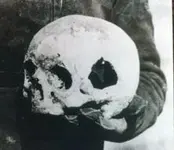Froghunter,
1. Back up all your information. Digitize everything you can and put it on two or three thumb drives.
2. Research as much as you can, the area where your dad's mine is. There is a story about a hiker that fell through the roof of an old cave by Weaver's Needle in the Superstition Mountains. When he came to, his leg was badly broken, and when he looked up, there was a life sized gold statue. He said there were also a lot of gold bars in this room. The hiker eventually used the statue to climb back out, but was in a very bad way. The story is that Ed Piper and Robert Crandall found the guy crawling down a trail in Needle Canyon. They took him to a clinic/hospital in Queen Creek, where the hiker died without explaining where he had gone. Another mystery of the Superstition Mountains.
2b. Get a good attorney at this point. You want one that will work on contingency. You will have to convince him your story has merit.
3. It doesn't matter whether you can locate a claim or not. It would not apply. Claims only apply to locatable (unprocessed) ore. Processed gold or silver (coins, bars, statues, etc) require a Treasure Trove Permit to legally recover. Since your mine will probably be in one of the many State or National Forests (as most of Arizona's Mountain Ranges are), you contact the BLM Ranger in charge of that particular area. You will have to convince him that your story has merit. That will be the most difficult thing you will ever have to do. They have heard every wild treasure tale in the book.
TREASURE TROVE
4. Your attorney will have to negotiate your ultimate treasure trove contract with the GSA (General Services Administration). The best you can ever hope to get is a 50/50 split (with all the recovery and incidentals coming out of your 50%).
.............. one other thing. Don't trust anybody. I apologize if this sounds accusatory (it isn't meant to be), but if people think you have a real treasure, you will get a million offers of help. Keep your team as small as possible. Have experts in any field of study necessary. One of the parts of your Treasure Trove Permitting Process is to have your site evaluated by a practicing Archaeologist. If your site is around a native habitation, or presents some historical significance, you better be very convincing in your treasure story. Also, don't have anybody on your team that you don't personally know, or know someone that knows them. Over the years, many people have taken on partners for a treasure hunt, and they turned up missing or dead. Jesse Capen from Denver is a good example. He came from Denver to find the Lost Dutchman. He disappeared for three years, until skeleton was found on Tortilla Mountain. While researching his movements, it was found out that he had met someone in Arizona. Shared a motel room. Had breakfast with, but nobody knew who this person was. There were never any charges filed, but why had this person not come forward when his partner disappeared? Just be very careful, and NEVER go into the mountains without people you know.
Best of Luck - Mike




